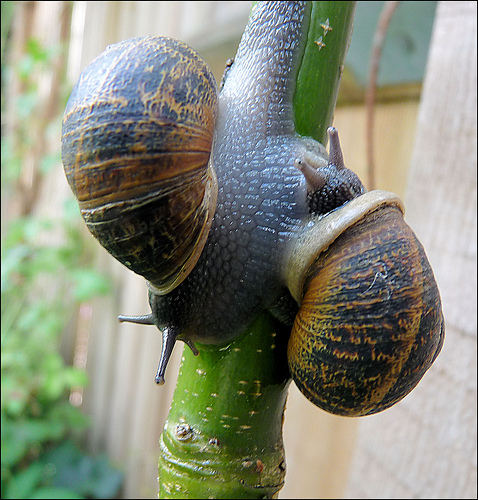
Reproduction
Neohelix lioderma and other Polygridaes are considered to be monoecious, where they can make their own sperm, receive foreign sperm and produce their own eggs. According to A.S. Tompa et al, in N. lioderma, they contain an organ called the ovotestis within the coiled shell in the digestive gland (1984). Within this organ, they make both sperm and ova. Calcium cells transport calcium from the blood to the uterine lumen where the eggs are inside. Then uterine gland cells help make the matrix of the eggs made of tight vesicles, waiting for the cross fertilization (Tompa et al. 1984).
Before copulation, land snails, in general, perform certain courtship behaviors. Once they find a mate, one follows the other’s mucous trail, consuming the mucous while following. In these dance movements, they form a circular path (Tompa et al. 1984). According to Tompa et al., these kinds of courtships can last from a couple of minutes up to thirty-four hours (1984). Then they simultaneously mate, one taking the “male” role and the other taking the “female” role. The “male” role consists of mounting on top of the other and the “female” role is to stay grounded. Then the copulation process starts. These courtships usually are done at night when it is raining because rain tends to increase mating behaviors (Tompa et al. 1984).
Most all snails can cross fertilize but in some rare cases, some can
self fertilize (Tompa et al. 1985). The only cases that self fertilization
is involved are when that individual is isolated for several months
from any population. This is in case there are no individuals to
mate with and so they can still carry on their genes, population to
population (1984).
The eggs are formed and stored by moving into the fertilization pouch where the sperm was kept from the previous copulation (Tompa et al. 1984). After the eggs have been fertilized by the sperm, the eggs go in the uterus and are shelled to exit through the genital opening (1984).
The formed eggs, which can range from .5 to 50 mm in diameter, are then laid in moist, calcium-enriched soiled area (Tompa et al. 1984). Pulmonates prefer moist areas because they are more likely to die in dry, drought stricken areas. Laying each egg can take 5 to 6 hours for the N. lioderma (1984). Once all the eggs are laid, the parent abandons the eggs. The hatching time of the eggs can vary based on the size of the eggs. Depending on the temperature of the environment surrounding the eggs, the eggs can hatch within a couple of weeks of being laid (1984).
Based on Tompa’s writings, Pulmonates have two choices: they can lay the eggs right away or keep the eggs inside of them if there is a delay (1984). These delays include temperature change, drought stricken areas, and/or no soiled areas (1984).
Giving credit where credit is due. Here are our References